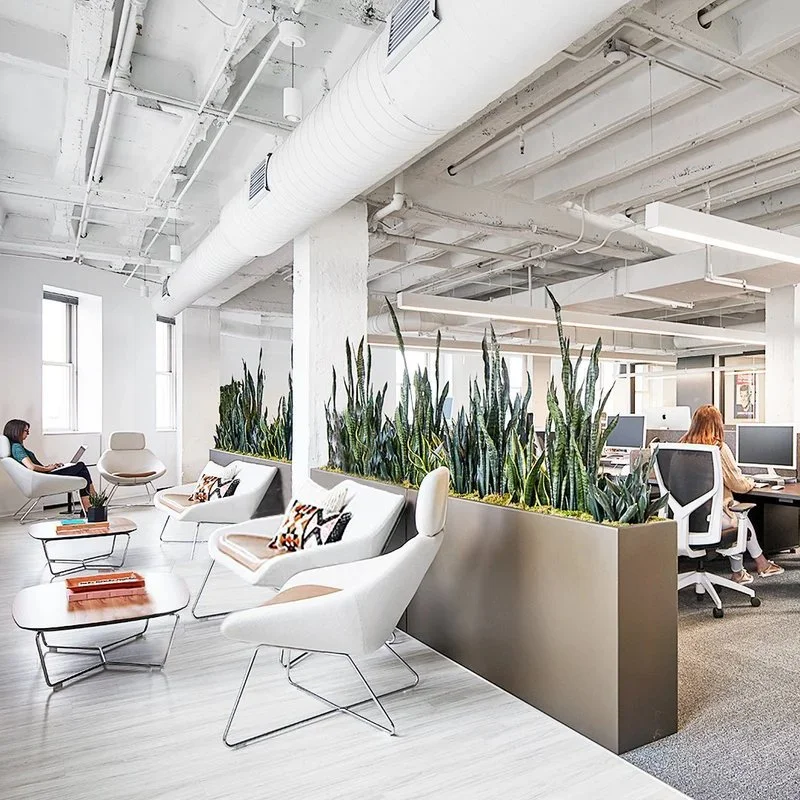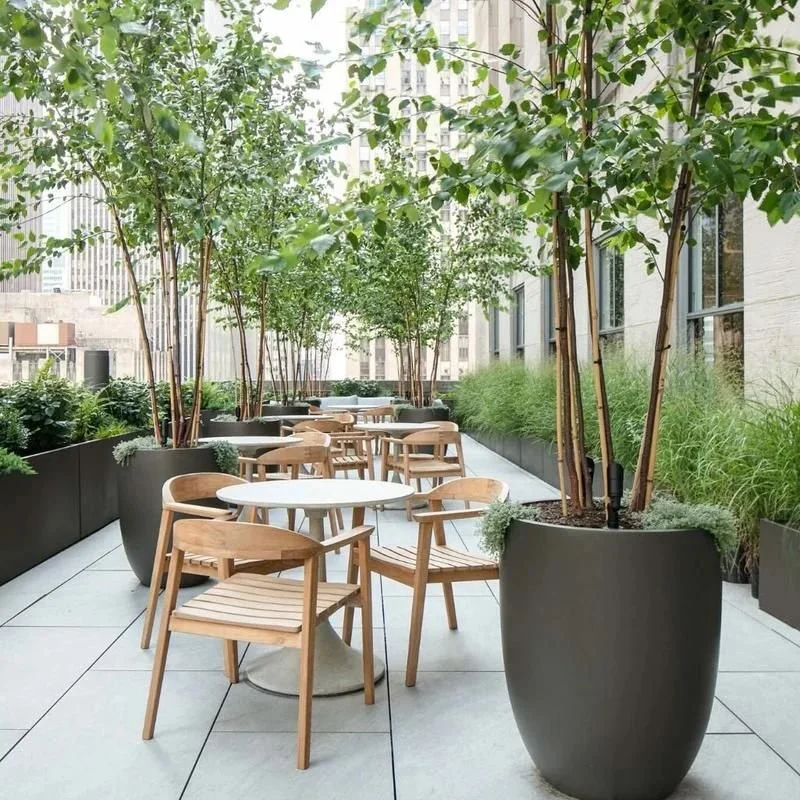A Guide to Four Common Planter Materials
As an expert in your field, you know there are many things to consider when working on a commercial or residential project. Just to specify the right planter, you need to consider design, color, and most often overlooked — the right material.
The material you choose will dictate lead-time, durability, cost, and customization options for your planters. In addition to all of this — the proposed location of your planters will also impact the type of material you should specify for your project.
This can be a lot to consider, especially if you are pressed for time. This is why we have outlined the four most common planter materials. Along with a description of the composition of each material, we also explain how each material is made into a planter, how to know if that material is right for your commercial or residential project, and finally a list of PureModern planter products that utilize the material mentioned.
Our goal is to make the decision-making process easy for you. If you have any other questions about getting started on purchasing your commercial planter, please contact us at 866-695-7651.
Powder-Coated Aluminum Planters
Composition
Aluminum is a chemical element found in the earth’s crust. Although aluminum is one of the earth’s most abundant elements, it is never found alone in nature. Therefore, aluminum is extracted from the substances with which it is found.
There are several different types of aluminum that can be sourced for a planter; however, PureModern uses what we consider to be the most durable planter material on the market: heavy gauge 5052 marine-grade aluminum alloy. This type of aluminum alloy is also commonly used in high-end commercial grade outdoor site furnishings, shipbuilding, and aircraft fabrication. Using this type of marine-grade corrosion-resistant aluminum ensures that your commercial planters can withstand the elements with little to no maintenance.
How is this planter made?
A shear and brake machine is utilized on aluminum sheets to form the desired pieces that create the shape of the planter. If detailed cuts are needed, we use a CNC laser table for precision cuts. Once the shaping is complete, we fuse-weld the outside edge of the planter which then penetrates through to the inside of planter, making the planter completely watertight.
PureModern fabricators then grind the welds so that all the edges are smooth, and the welding beads are invisible. Finally, the planter is prepped and the aluminum is powder-coated.
Powder-coating is a four-step process. First, a prepaint coating is applied to the planter and dried. Then, the planter is electrically charged so the powder will bond to the planter. The planter is then powder-coated with our VOC-free powder. Finally, the powder is cured under heat, which creates a hard, long-lasting finish.
For powder-coating, we only use TIGER Drylac(r) Series 38 powder coating. TIGER Drylac® is VOC-free and made for industrial applications such as military equipment and communication towers. It is also proven to be weather and UV-ray resistant. According to the manufacturer, “Based on 5-year Florida exposure, TIGER Drylac® Series 38 exhibits 5.0 (Hunter) color change and > 30% gloss retention.” Finally, TIGER Drylac® Series 38 also complies with the American Architectural Manufacturing Association’s specification AAMA 2604.
For planters that are large enough to accommodate small ornamental trees or large shrubs, we will add reinforcements. Reinforcements ensure that the planter is structurally adequate.
Why aluminum?
The benefit of using aluminum for a planter is that it does not rust (rust only occurs in iron and steel corrosion) and is powder-coated for durability. Powder-coating the planter ensures durability because commercial powder-coating formulations have characteristics that enable the planter to withstand UV rays, temperature changes, and other severe weather conditions.
In addition to its durability, aluminum planters can be modified to add elements such as castors, lights, speakers, or even toe kicks, which creates the illusion that the planter is floating. It is worth noting that aluminum is easily customizable and can be created into most geometric shapes.
A powder-coated aluminum planter is perfect for all interior or exterior applications, can be powder-coated in almost any color, and fabricated to be large enough to hold an ornamental tree.
Does this material fit your needs?
PureModern commercial-grade powder-coated aluminum planters are perfect for a project that requires low-maintenance and lightweight metal planters that can withstand extreme weather conditions as well as high-traffic areas.
We also recommend commercial grade aluminum if you need a customized planter. Aluminum planters are available in a variety of sizes, shapes, and configurations. Although powder-coated aluminum planters are typically more expensive than fiberglass, they will last longer than a fiberglass planter, and the powder-coating will not fade as soon as the paint used on fiberglass will.
This planter material works well in all indoor and outdoor applications but works especially well on rooftops or places where the overall weight of the planter, plant, and filler is a consideration.
PureModern Aluminum Planters
Modern Elite Wide Rectangle Planter
Fiberglass Planters
Composition
Appropriately referred to as glass fiber, fiberglass is a composite material made of molten glass that has been forced through small holes and then woven into fibers. Fiberglass has several applications such as insulation in your ceiling or, in our case, it is layered with resin to make a planter.
How is this planter made?
We first create a mold (also known as a plug) made of wood or plastic of the desired shape and size. Then, the fiberglass material is hand layered in the mold; once the planter is dry, it is removed from the mold and then continually sanded until all the imperfections are gone.
It is important to note that fiberglass resin planters are resistant to corrosion and UV damage due to the structural integrity of the composite material. However, the durability of fiberglass planters only increases during the last step as described below.
During the last step, the planter is painted with a primer and your color of choice. At PureModern, we hand spray each fiberglass planter in North America using BASF commercial-grade automotive paint to ensure that your fiberglass planters are long-lasting and resistant to UV rays.
BASF paint systems strive to meet the requirements for performance, quality, and safety. As mentioned above, these paints are UV, corrosion, and frost resistant. BASF paint systems feature specialized resins, pigments, and additives for enhanced coating performance to decrease UV damage.
Sidebar: We recommend getting a color sample before ordering your planter(s) so that you are sure of the color you are receiving. Read more about the importance of getting color samples.
For larger planters, internal reinforcing is added as part of the integral structure and layered with the fiberglass during manufacturing to ensure the planters are structurally adequate for a small ornamental tree or larger plant choices.
Why fiberglass?
The benefit of using PureModern fiberglass planters is that they are lightweight and resistant to corrosion, frost, and UV-rays. Most fiberglass planters also require very little maintenance and do not need to be taken indoors during the winter months.
Like powder-coated aluminum, fiberglass is a great material for planters, especially when the total weight is a factor for rooftop projects or high-rise balconies.
Does this material fit your needs?
Fiberglass will fit the material needs for your planters if you need a planter that is lightweight, low-maintenance, and budget-friendly. Fiberglass can be painted in almost any color.
It is important to note that it is challenging to customize the shape of a fiberglass planter. To customize a fiberglass planter, the manufacturer needs to first make a new mold before creating the final product. This makes the wait time for the planter much longer (up to 14 to 16 weeks) than for a customized powder-coated aluminum planter. With that said, if there is no time constraint and the desired shape cannot be done in metal, fiberglass is the material of choice. (Note: there is a minimum quantity purchase requirement depending on the sizes of the custom planters order.)
Shop PureModern fiberglass planters
PurePots Balboa Low Rectangle Planter
PurePots Geoff Tabletop Square Planter
COR-TEN Steel Planters
Composition
COR-TEN is the United States Steel trademark name for weathering steel. COR-TEN is a group of steel alloys. The name COR-TEN comes from a combination of two of its essential properties: corrosion resistance (COR) and tensile strength (TEN).
How is this planter made?
A shear and break machine cuts sheets of COR-TEN steel planters into the desired shape. Then, the cut sheets are fully welded so that the planter will be watertight.
Once the planter is shaped and welded, the visible welds are ground down.
COR-TEN steel planters look like raw metal when first delivered to your project location. However, once the planter is installed in an outdoor location, it will patina to an orange-brown color (patina is a key final process for COR-TEN steel).
If requested, we can pre-treat the planter with a chemical before shipment to speed up the patina process.
Why weathering steel?
One important characteristic of COR-TEN steel planters is that it patinas beautifully after exposure to the climate.
Because the outdoor elements are essential to the patina process, we only recommend COR-TEN steel planters for outdoor use. This patina is key because it protects the planter from further corrosion, therefore making COR-TEN steel planters a long-lasting option.
Before purchasing planters made from COR-TEN steel planters, it is important to understand that the patina process may bleed onto the supporting surface and possibly stain the surrounding area.
Does this material fit your needs?
COR-TEN steel planters will fit your needs if you want modern industrial design, don’t mind waiting for the material to patina, and the surrounding area of the planter can tolerate metal bleeding.
Due to the cost of weathering steel, these planters are also more expensive than powder-coated aluminum planters, are substantially heavier than aluminum and fiberglass planters, and can take up to six to eight weeks for fabrication.
PureModern COR-TEN Planters
To purchase your COR-TEN steel planter, please click here.
Stainless Steel Planters
Composition
Stainless steel is a type of alloy of iron that has a minimum of 10.5% chromium. Chromium creates a thin layer of oxide on the surface of the steel that makes this steel tarnish and rust-resistant.
How is this planter made?
First, sheets of metal are cut into the right shape. The resulting piece is then, in most circumstances, fuse-welded to be watertight and then the welds are ground and dressed to look like brushed stainless steel. The dressing is done by hand and with abrasives, which is time-consuming, but very appealing if an ultra-modern design is desired.
Why Stainless Steel?
Though stainless steel is beautiful, it can be too heavy, and costly for certain projects. If you love the look of stainless steel, we can create the same look by customizing powder-coated aluminum planters.
Material Guide Reference Sheet
For your convenience, we have created this spec sheet. Feel free to save this image to your desktop for a quick reference to materials.
We hope this guide helps you feel more confident about choosing the right material for your project. If you have any questions, we would love to hear from you! Please contact us at 866-695-7651, or click here to purchase the planters for your commercial project.























